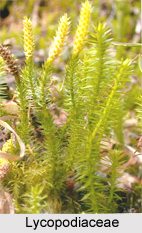 They bear spores on specialized structures at the apex of a shoot; they resemble a tiny battle club, from which the common name derives. They are non-flowering and do not produce seeds. The species of Lycopodiaceae are terrestrial, protostelic vascular plants. The free-living plant is dichotomously branching and consists of a rhizome with adventitious roots as well as an aerial portion with numerous, closely spaced, spirally disposed microphyllous leaves.
They bear spores on specialized structures at the apex of a shoot; they resemble a tiny battle club, from which the common name derives. They are non-flowering and do not produce seeds. The species of Lycopodiaceae are terrestrial, protostelic vascular plants. The free-living plant is dichotomously branching and consists of a rhizome with adventitious roots as well as an aerial portion with numerous, closely spaced, spirally disposed microphyllous leaves.
Scientific Classification
Kingdom: Plantae
Division: Lycopodiophyta
Class: Lycopodiopsida
Order: Lycopodiales
Family: Lycopodiaceae
Uses of Lycopodiaceae
The spores have been used by violin makers as pore filler. In some places during certain lunar phases were used as a remedy for diseases of the eye.
Propagation of Lycopodiaceae
The propagation techniques used include tissue culture, division, aerial growth, layering, cuttings and stem propagation. In stem propagation there is a modified cutting/layering technique. Top sections measuring 2-6 inches are removed from the stock plant. These are kept moist, humid and warm. The young plants are not disturbed until they grow to approximate size of 2 inches. Thereafter numerous basal shoots grow.



















